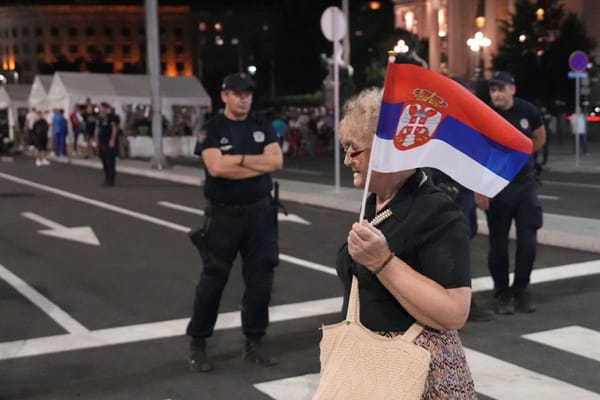On November 1 of last year, 16 people died in a collapsed railway canopy in the city of Novi Sad in northern Serbia. The disaster, widely attributed to graft in public procurement and favoritism toward government-aligned contractors, stoked public outrage over corruption and triggered an enormous outpouring of popular discontent. Protests hundreds of thousands strong, encompassing people from across all walks of life, overtook cities across the country for months.
“Serbia was once the paradigm for peaceful revolutions.”
As the protestors have refused to melt away even as the disaster recedes into the past, security forces have grown increasingly heavy-handed and brutal. At the same time, government measures to defuse the unrest—such as promising fresh elections or making public transport free in major cities—have been met with contempt by the protestors. Yet despite the intensity of popular feeling, the protestors have refused to channel their frustrations through the parliamentary opposition parties, seeing them as ineffectual, fragmented, and no less corrupt than the ruling elite. Some commentators have even suggested that Serbia is on the brink of a low-grade civil war.
Many outside observers frame the questions of Serbian and Balkan politics in terms of renewed geopolitical rivalry, seeing creeping regional authoritarianism as the result of Russian efforts to infiltrate its former sphere of influence by exploiting links with their Orthodox brethren in Serbia. Others have drawn attention to Serbia’s continuation of the old Yugoslav-era diplomacy of non-alignment, with Belgrade balancing between Xi, Putin, and Trump while at the same becoming a major arms exporter to Ukraine in its efforts to repel the Russian invasion. Others still have drawn attention to the ways in which the European Union has helped prop up regional strong-men including Serbia’s Aleksandar Vučić, prioritizing authoritarian stability over the electoral fluctuations of liberal democracy. But by framing Serbia’s politics predominantly in terms of international order, these perspectives miss how Serbia’s internal politics have evolved into this grinding deadlock, quite aside from policies in Brussels and Moscow, let alone Beijing.
It is often forgotten today that Serbia was once the paradigm for peaceful revolutions in the era of unipolarity, offering the prototype of the so-called color revolution, that model of internationally-managed regime change intended to roll back authoritarianism in the old Communist bloc and consolidate the spread of global liberal democracy during the 2000s. In October 2000, the communist-turned-nationalist Serbian strongman, Slobodan Milošević, was overthrown by a popular street movement protesting contested elections. Backed by extensive student support and a programme of civil disobedience coordinated through well-funded networks of NGOs with snazzy branding, the OTPOR (“Resistance”) movement was born. The emblem of the clenched fist and slogan of “resistance” in Cyrillic letters would gain worldwide renown among liberal activists, although the branding would be subsequently upgraded to a color scheme when the system was franchised to Georgia (the 2003 Rose Revolution) and then Ukraine (the 2014 Orange Revolution).
Amid Washington’s regime change interventions in Afghanistan and Iraq, Serbian October seemed to liberal internationalists to offer an alternative model for global civil society. It was a paradigm of peaceful change that, it was believed, could do more than overcome thuggish ex-Communists such as Milošević. It was also supposed to transcend national politics altogether, with supposedly apolitical NGOs assuming more significance than multiparty elections.
The problem, however, is that a color revolution is really no revolution at all. Rather than one new ruling class replacing another, when Milošević was ousted from power, the Serbian state security apparatus, media and nascent oligarchy simply switched its support from him to the NGO coalition. The Serbs had a name for these people—“tumbling pigeons”—named for trained birds that perform fantastic acrobatics mid-flight. These are the elites who have remained in charge in Serbia throughout the period of supposed flourishing liberal democracy and during the slide into Vučić’s autocratic rule since 2014.
The failure of the 2000 revolution haunts Serbian politics to this day. The country’s problems today are still rooted in the anti-politics of global civil society, with an enormous mass opposition movement that rejects organized political representation—with the result that it remains confined to the streets, unable to take power or enact meaningful change. The protestors’ problems are now compounded by the fact that since Donald Trump pulled the plug on USAID, the NGOs are in no position to take the lead.
“Resistance” could work as a slogan in the era of unipolar globalization. Then, the question of what comes after “resistance” was obvious: globalized consumer capitalism under US leadership. But when America no longer enjoys uncontested international leadership, the notion that national political change was simply a matter of alignment with the hegemon no longer applies.
Rather than representing a new era of geopolitical rivalry playing out in regional theatres such as the Balkans, the deadlock of Serbian politics embodies the dead legacy of globalist politics. In the unipolar era, national representation withered away, to be replaced by NGOs and multinational corporations. The question for us today is whether the era of multipolarity will create opportunities for actual revolution, as opposed to internationally directed regime-change.
